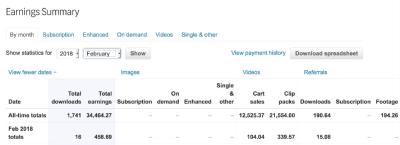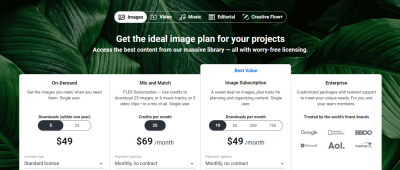If you’ve ever browsed through a website filled with stunning photos, illustrations, or videos, chances are you’ve come across Shutterstock. It’s one of the biggest platforms out there for stock media, connecting talented creators with businesses, marketers, and individuals who need high-quality visuals. But have you ever wondered how Shutterstock makes its money and how creators earn from their work? That’s what we’re diving into today — understanding how
How Shutterstock Calculates Commission Fees
So, you’ve uploaded your best images or videos to Shutterstock — now, how do you get paid? The answer lies in understanding their commission structure, which is a bit different from other stock platforms. Basically, Shutterstock pays contributors a percentage of the sale price whenever someone licenses their content. But here’s the twist: that percentage isn’t fixed and can vary based on several factors.
Let’s break it down:
- Contributor Level: Shutterstock assigns levels based on your sales volume. New contributors start at a basic level and can move up to higher levels as they sell more, unlocking higher royalty rates.
- Type of License: Shutterstock offers Standard and Enhanced licenses. Standard licenses usually bring in lower commissions, while Enhanced licenses — which are for more extensive or exclusive uses — tend to pay more.
- Subscription vs. On-Demand Sales: Shutterstock has two main purchasing options. Subscription sales are generally at a lower price point but can generate volume, while on-demand (or single image) sales tend to pay higher per-download royalties.
Here’s a simplified overview of the typical commission percentages for contributors:
| Contributor Level | Royalty Rate (Standard License) | Royalty Rate (Enhanced License) |
|---|---|---|
| Level 1 (New contributors) | 15% | 30% |
| Level 2 | 20% | 30% |
| Level 3 and above | 30% | 33% |
Keep in mind, these percentages are approximate and can vary depending on specific sales and licensing types. Also, Shutterstock sometimes offers special promotions or adjustments, so it’s always good to check their latest contributor guidelines. The key takeaway is that as your portfolio grows and you climb the contributor levels, your commission rates increase, leading to higher earnings per sale. Understanding this structure can help you strategize which types of content to create and how to optimize your sales for better income. Happy creating and earning!
Factors Influencing Your Earnings on Shutterstock
When it comes to earning money through Shutterstock, there’s more at play than just uploading pretty images. Your actual earnings depend on a variety of factors that can either boost your income or limit it. Let’s break down some of the key elements that influence how much you can make.
1. Your Contributor Level
Shutterstock has different contributor levels, such as Standard and Premier. As you upload more approved content and generate consistent sales, you can move up these levels. Higher levels often come with increased commission rates, meaning you get a bigger cut per sale. So, the more quality content you provide, and the more you grow within the platform, the better your earning potential.
2. Content Quality and Relevance
Quality always matters. High-resolution images, well-composed photos, and relevant keywords help your content stand out. Shutterstock’s algorithm favors content that sells well, so creating popular themes, trending topics, or unique visuals can lead to more downloads and, consequently, higher earnings.
3. Licensing Types
Shutterstock offers different licensing options—Standard and Extended. Standard licenses are included in your commission calculations, but Extended licenses, which are sold at a higher price, can boost your earnings when purchased. Understanding the differences and optimizing your content for high-demand licenses can make a notable difference in your income.
4. Customer Demand and Trends
Staying on top of current trends, seasonal topics, and popular themes can significantly impact your sales. For example, during holidays or major events, certain types of images tend to sell more. By aligning your content with what buyers are actively searching for, you increase your chances of earning more.
5. Geographic Factors
Some countries and regions have higher purchasing power, influencing sales volume. If your content appeals to audiences in these areas, you might see higher earnings. Additionally, Shutterstock’s global reach means your content can be purchased worldwide, but understanding where your buyers are can help you tailor your efforts.
In summary, your earnings on Shutterstock aren’t just about uploading images. They’re shaped by your contributor level, content quality, licensing types, current trends, and regional demand. Focusing on these factors can help you maximize your revenue over time.
Comparing Shutterstock’s Commission Rates with Other Stock Platforms
Not all stock image platforms are created equal when it comes to how they pay contributors. If you’re serious about earning a sustainable income, it’s worth comparing Shutterstock’s commission rates to other popular stock sites. Let’s look at some of the major players and see how they stack up.
| Platform | Commission Rate / Earnings Model | Additional Notes |
|---|---|---|
| Shutterstock | Starting at 15% for new contributors, increasing up to 42% as you grow and reach higher contributor levels. | Offers a tiered system; higher levels earn more per sale. |
| Royalty rates range from 15% to 45%, depending on exclusivity and sales volume. | Exclusivity can boost earnings but limits distribution channels. | |
| Standard contributor earns around 33% of the license fee. | Payments are made monthly; integrated with Adobe Creative Cloud. | |
| Commission rates vary from 34% to 42%, based on your lifetime earnings. | Higher earnings are possible with exclusive content. | |
| 123RF | Offers a tiered system, with earnings typically around 30-60% per sale. | Higher rates for exclusive contributors, with bonuses for volume. |
So, what does this all mean? Shutterstock’s starting commission rate is a bit lower than some competitors like Adobe Stock and Depositphotos. However, its tiered system rewards consistent and high-quality contributors with increased rates, which can lead to more substantial earnings over time.
Exclusivity is a common theme across platforms. For example, iStock and Depositphotos offer higher royalties if you choose to be exclusive, but that comes with restrictions. Shutterstock’s open approach allows you to upload your content elsewhere too, providing flexibility but potentially limiting your earnings growth unless you move up the contributor levels.
Ultimately, the best platform for you depends on your niche, content style, and how much effort you want to invest in building your portfolio and reputation. Comparing these rates and understanding each platform’s model can help you make informed decisions to maximize your earnings across multiple sites.
Tips to Maximize Your Earnings as a Contributor
Thinking about boosting your income on Shutterstock? You’re in the right place! While understanding the commission structure is key, there are plenty of practical strategies to help you earn more from your contributions. Here are some tips to get you started:
1. Focus on High-Demand Topics and Niches
Research trending subjects and popular niches that buyers are actively searching for. For example, if you notice a surge in demand for remote work imagery or sustainable living themes, creating content around these areas can lead to more sales. Use Shutterstock’s search trends and industry reports to guide your content creation efforts.
2. Upload Consistently and Regularly
Consistency pays off! The more high-quality images, videos, or illustrations you upload, the higher your chances of getting noticed by buyers. Make a schedule—whether it’s weekly or bi-weekly—and stick to it. Over time, a robust portfolio will help increase your visibility and earnings.
3. Optimize Your Keywords and Titles
Think of your metadata (titles, tags, descriptions) as the map that guides buyers to your content. Use relevant, specific keywords that accurately describe your work. Avoid stuffing keywords; instead, focus on natural, descriptive language that matches what buyers might search for.
| Tip | Why It Matters |
|---|---|
| Use accurate keywords | Helps your content appear in relevant searches |
| Write clear titles | Draws attention and improves click-through rates |
| Provide detailed descriptions | Increases discoverability and context |
4. Create Unique and High-Quality Content
Quality always trumps quantity. Buyers are more likely to purchase original, well-composed, and technically sound content. Invest in good equipment, pay attention to lighting and composition, and edit your work carefully. Unique visuals that stand out will earn you better commissions and more repeat buyers.
5. Promote Your Work Outside Shutterstock
Share your portfolio on social media, personal websites, or photography communities. Building your personal brand can attract more viewers and potential buyers to your Shutterstock contributions. The more exposure your work gets, the higher your chances of making sales and earning commissions.
Conclusion and Final Thoughts on Shutterstock Commission Rates
Understanding how Shutterstock’s commission rates work is just the first step toward maximizing your earnings. Remember, your success depends on a mix of strategic content creation, smart optimization, and consistent effort. While the commission structure might seem complex at first, focusing on producing high-quality, in-demand content and promoting it effectively can lead to steady growth in your income.
Keep experimenting with different types of content, stay updated on market trends, and don’t get discouraged by initial slow periods. Over time, as your portfolio grows and your skills improve, you’ll find more opportunities to earn more through Shutterstock’s platform. Happy contributing, and here’s to turning your creative passion into a rewarding side hustle or full-time gig!


